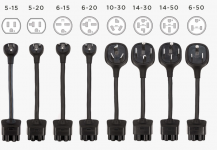brycenesbitt
Senior Member
- Location
- United States
And you never will. There's no provision for an EVSE neutral to extend to the vehicle.I agree. I've never seen a charger that requires a neutral, yet most of the plug in chargers I've seen are configured for a 14-50R. So if you're prewiring for future, it makes sense to just run a neutral so you can properly setup a 14-50R.
The sole and as far as I can tell only reason that NEMA 14-50R rather than NEMA 6-50 became common is the prior generation of dryer or stove outlets.
NEMA 6-50 reduces copper cost, works the same.
@tortuga is exactly right above as to why.
And you can install 6-50 now for ranges, as long as you get a model that does not really use neutral (that's most of them, European ones for sure, no promises).
With a hardwire EVSE of course: no neutral no problem.


